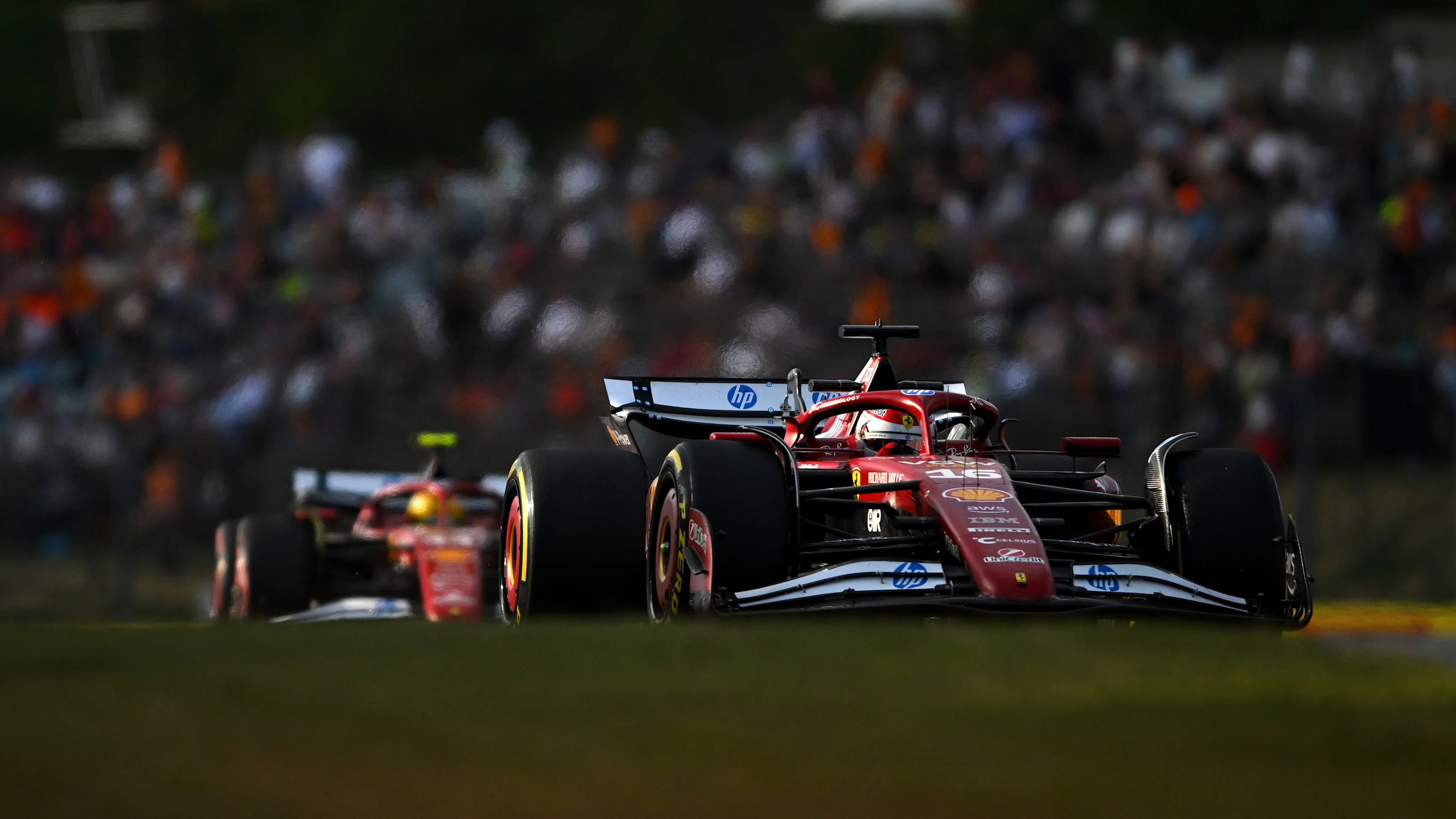The 2025 Hungarian Grand Prix looked to be a strong showing for Charles Leclerc and Ferrari—at least for the first 40 laps.
Starting from pole and controlling the race through the first two stints, Leclerc seemed on course to claim victory ahead of a charging McLaren duo.
But by lap 41, the momentum shifted entirely. What began as a display of composure and speed deteriorated into a dramatic collapse that saw Leclerc finish 42 seconds behind race winner Lando Norris. At the core of this downfall?
A combination of plank wear, increased tire pressures, and a troubling lack of communication from the Ferrari pit wall.

A Dream Start Turns to Disaster
Leclerc executed a flawless launch and controlled the race from the front, maintaining a two-second cushion over Oscar Piastri through the opening stints. The Ferrari looked stable, fast, and efficient—even managing its tires well on both medium and hard compounds. But then came lap 40. After his second and final pit stop, Leclerc’s performance fell off a cliff. In the final stint, he was lapping an average of 1.5 seconds slower than Piastri—despite running on a significantly lighter fuel load.
Not only was he slower than the McLarens, but even Mercedes’ George Russell, who had started from the midfield, was catching and eventually overtook him. The dramatic drop in pace wasn’t due to driver error. It was, instead, a symptom of technical and strategic mismanagement rooted in a resurfacing issue Ferrari hoped they had left behind: plank wear.

What Is Plank Wear—and Why It Matters
The plank (or skid block) is a wooden board fixed beneath an F1 car’s floor to ensure teams comply with ride height regulations. Excessive wear on the plank, usually from the car being run too low, can lead to disqualification—as Ferrari painfully learned earlier in the season in China, when both Leclerc and Sainz were disqualified post-race.
To mitigate this risk in Hungary, Ferrari tried a conservative approach. Instead of raising the ride height—a more straightforward but performance-sapping fix—they attempted to control the issue dynamically by adjusting settings and tire pressures. Unfortunately, these changes introduced other performance limitations, especially in Leclerc’s final stint.
The FS1 Mode Change: Performance Bottleneck
From lap 9, Ferrari initiated an engine mode change called FS1, reducing RPM at the end of key straights by about 300 RPM. Telemetry showed that Leclerc lost around 7–8 km/h in top speed entering Turns 1 and 4 compared to earlier in the race.
While Ferrari’s intentions were rooted in protecting the plank from excessive wear, this change compromised Leclerc’s ability to defend and attack—particularly against McLaren’s high-speed pace. After the first pit stop around lap 19, FS1 was deactivated temporarily, allowing Leclerc to hold off Piastri for a while. But the restriction returned by lap 28, followed by another crucial radio message.

Leclerc’s Frustration Boils Over
Around lap 27, Leclerc came on the radio in a tone that could only be described as frustrated:
“Yeah, I can feel what we discussed before the race. We need to discuss those things before doing those.”
His message was clear: strategy changes were being made without driver feedback or dialogue. Shortly after, Leclerc was instructed to be careful in Turn 11, the fastest corner at the Hungaroring and a known hotspot for plank scraping. The timing of this caution—and the lack of proactive setup changes—suggested that Ferrari were reacting rather than planning.
Lap 40: The Moment Everything Fell Apart
Leclerc’s second stop came on lap 40, and it marked a stark shift in pace. Ferrari appeared to have drastically increased tire pressures—possibly by 2 to 5 PSI—to prevent the plank from scraping the tarmac. While this may have helped minimize the risk of disqualification, it destroyed the car’s grip and overall performance.
Here’s why tire pressure is so important: when pressures are higher, the contact patch between tire and track becomes smaller. That reduced contact means less mechanical grip and compromises the aerodynamic performance as the floor no longer generates the same level of downforce. Combined with the restrictions imposed by FS1, Leclerc’s car became undrivable.
He said it best over the radio:
“This is so incredibly frustrating. We’ve lost all competitiveness. You just have to listen to me. I would have found a different way of managing those issues. Now it’s just undrivable.”
A Lack of Communication—and a Loss of Trust
What stands out most isn’t just the performance drop—but the way Ferrari managed it. There was no clear communication to Leclerc about the tire pressure changes before they were implemented. That failure to involve the driver in a strategic decision that drastically changed the car’s behavior speaks volumes.
Modern F1 is about team synergy. Engineers and drivers must collaborate constantly to adapt during a race. In contrast, Ferrari’s top-down approach—making decisions without input from their lead driver—left Leclerc helpless to adapt his driving style. A more collaborative team might have sought to work around the plank issue through line changes, curb management, and driver-specific inputs, rather than applying a blanket mechanical fix like inflating tire pressures.
The Bigger Picture: Ferrari’s Struggles with the SF-25
Hungary’s Grand Prix was a microcosm of Ferrari’s broader challenges with the SF-25 chassis. The car’s narrow operating window makes it highly sensitive to ride height, tire pressures, and aerodynamic balance. When everything clicks, it’s fast. But more often than not, small deviations in setup or conditions send it spiraling down the order.
It’s also worth noting that Ferrari is still grappling with confidence issues in their engineering and strategic decision-making. Rather than trusting the pace and finding smarter ways to manage plank wear, they went with a drastic tire pressure hike that compromised their race entirely.
A Season Turning Point—or More of the Same?
Leclerc’s performance collapse in Hungary is not an isolated incident. It’s part of a troubling pattern where Ferrari prioritizes reactive fixes over pre-emptive collaboration with its drivers. While the summer break provides a mental reset, it won’t solve the deeper structural issues unless Ferrari changes the way it approaches race-day decisions.
Teams like McLaren and Mercedes have shown how communication and adaptability can rescue a weekend. For Ferrari to return to championship contention, they’ll need more than a fast car—they need trust, dialogue, and flexibility between pit wall and driver.
Final Thoughts
The Hungarian Grand Prix showed just how fine the margins are in Formula 1. Leclerc’s pole-to-plummet performance wasn’t the result of poor driving or external chaos, but of internal mismanagement. It’s a classic case of Ferrari being Ferrari: overly cautious, strategically scattered, and resistant to letting their drivers lead from the cockpit.
As F1 enters the second half of the 2025 season, one thing is clear—if Ferrari wants to compete with McLaren and Red Bull, they must learn to listen before they act.
Let’s hope the summer break is more than just a rest—it needs to be a reboot.
Full Video:





